Today, we’re taking a virtual tour to some of the most beautiful places in Spain to visit. Whether you’re looking for history, natural beauty, or modern culture, Spain has it in spades.
View in gallery
It almost goes without saying the Spain is a hot holiday destination. After all, the country emanates cutting-edge beauty and a rich history from every direction. From its expansive mountain ranges and world-class coastal lines to a vibrant culture, sunny climate, and decorated past, a list of the most beautiful places in Spain could seem endless.
Unfortunately, most vacationers to Spain confine their visit to a handful of attractions among a few cities, leaving out numerous must-see destinations unexplored. Moreover, with a dynamic culture and a friendly population, your visit to Spain will seem far too short.
So, let us help you build a solid itinerary to get the most out of your trip to Spain. Whether you’re fond of art galleries or curious to catch a famous flamenco dance, our must-visit Spanish destinations will definitely add some weight to your bucket list.
What Makes Spain a Special Tourist Destination?
Spain is rich in breathtaking natural features, with sunbathed beaches, crystal-clear waters, and vast stretches of mountainous ranges. The nation’s rich history is evident in awe-inspiring museums and the stunning architecture that represents its turbulent past.
Diversity is a fitting description of Spain’s irresistible appeal. Spain merges ancient and modern, with its attractions spanning beyond natural landscapes to a captivating lifestyle and people. Sunny weather and golden sandy beaches make the perfect combination for a tourist’s mecca.
Moreover, the tumultuous past of civilizations that rose and fell can be seen in its architecture. The Roman ruins, colossal cathedrals, and Moorish palaces are time-stamps of a distant past.
And yet, life in Spain is easygoing and genial, with a sensual focus on the good things. Commonly enjoyed cuisines are from recipes that have successfully transitioned through a number of generations, most often simple but delicious. While heritage and cultural identity are important to Spanish people, they also have a distinctly modern edge. Spain’s artists, chefs, architects, and musicians are world-famous for pushing the envelope. The contrast between old and new is often stark, but it’s always very Spanish.
The Most Beautiful Places in Spain to Visit Before You Die
Knowing where to begin when touring a country drenched in such diverse attractions and history can be mind-boggling. That’s why we’ve done your homework for you, and now present you with the most beautiful places to visit in Spain.
1. Barcelona: The Catalonia Region Capital
View in gallery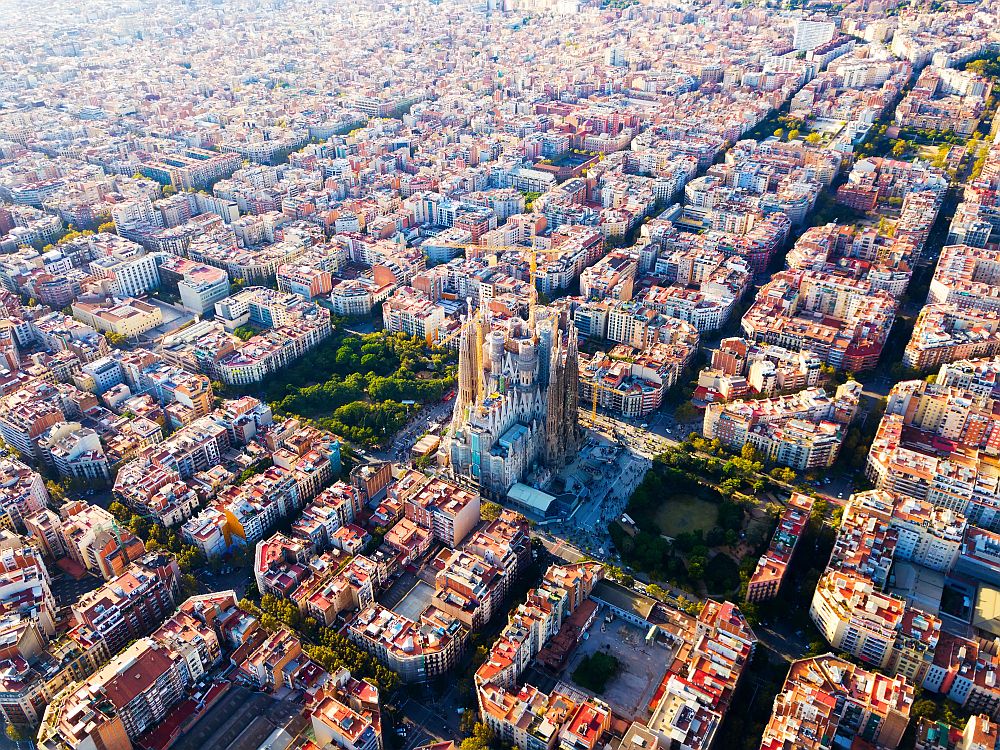
A fun-filled city that boasts a vibrant nightlife, delicious cuisines, dreamlike edifices, excellent shopping malls, and a world-class beach–that’s everyday life for those who call Barcelona home.
Surreal buildings designed by the prominent architect Antoni Gaudi are a must-see when you visit. Many of his buildings push the boundaries of conventional taste, but the execution is always on point and never fails to astound.
Chief among these architectural marvels is the La Sagrada Familia, a monumental church sanctuary. It attracts the most visitors among his works; close to 3 million visitors annually. The iconic masterpiece remains unfinished but impresses with its unconventional supports and ornate slender spires. The church is a UNESCO World Heritage site, as are a number of other buildings in the city created by Gaudi and other talented Catalonian architects.
The church is still under construction since 1882, and is anticipated to be completed in the mid-2020s. Nonetheless, you can visit the site and enjoy magnificent views of the city from one of the spires of what will possibly be the world’s tallest church.
You can find more of Gaudi’s creative works at the famous Park Guell; mainly benches and sculptured works. It’s a fantastical artistic park that offers sweeping views of the city.
After your architectural tour, we recommend you take a leisurely stroll along the narrow gothic streets to sample the numerous urban bars and restaurants. Just be aware that late nights in Barcelona all-too quickly become early mornings; we recommend you embrace the pace of life to experience the city to its fullest!
2. Granada: The Home of Alhambra Palace
View in gallery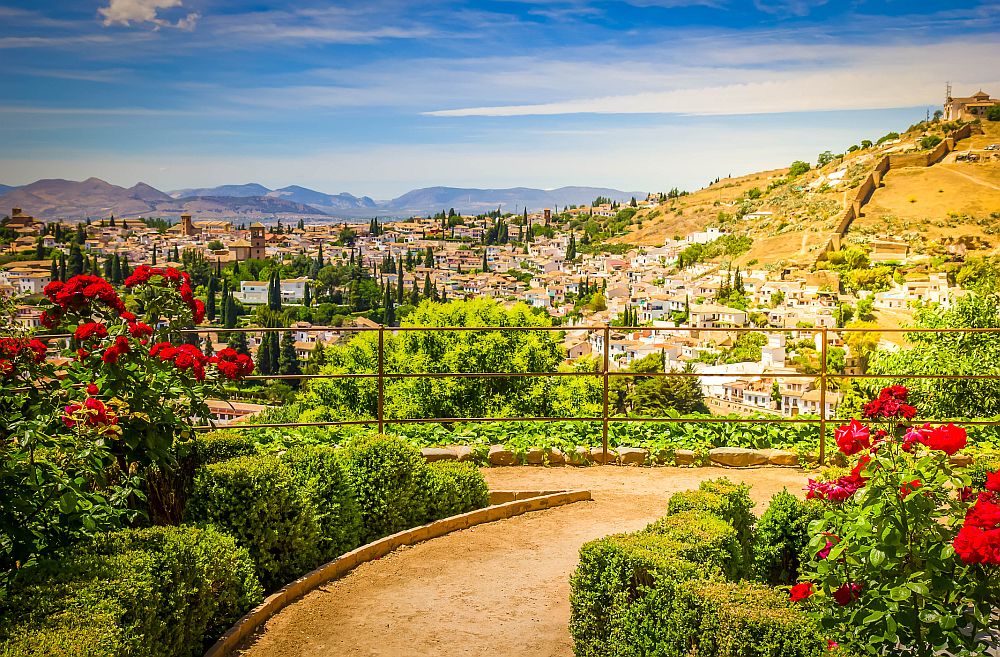
Tucked at the foot of the Sierra Nevada mountains, Granada is a rustic yet regal stunner. The city is located in the Andalusia region on the southern end of the country. Awash with Moorish architecture of the middle-ages, it’s one of the most beautiful places in Spain. And the most outstanding of these monuments is undoubtedly the Alhambra Palace.
Nestled on a hill, the Alhambra consists of an extensive spread of palace complexes. The palace is elegantly set amidst lush green gardens, with the majestic Sierra Nevada mountains providing a spectacular backdrop to complete this scenic landscape. Not only is it Spain’s most visited tourist attraction, it’s arguably one of the top destinations in Europe.
Alhambra palace brings together several towers and buildings, a mosque, and well-kept gardens. The Moorish signature is evident in the curved arches and delicately-executed stone carvings.
From this castle, savor views of the city of Granada and the towering Sierra Nevada mountain range. From the terraces of Generalife’s garden decorated with blossoming flowers and punctuated with springs, enjoy breathtaking views of the palace surroundings in the perfect environment to kickback.
The Nasrid Dynasty established this opulent palace in 889, whose artistry permanently reminds us of the Islamic period in Spain in the Middle Ages. In the 16th Century, it was refurbished by Christian Kings, making it a cultural melting pot that fuses European medieval architecture with Moorish-style designs. Owing to its unique roots, Alhambra is a UNESCO World Heritage site.
While in the city of Granada, be sure to sample the iconic streets of Albayzin that are also a World Heritage Site. Tour the Scaromonte, a hilly area high up in Granada with lots of caves. It’s also a famous playground for flamenco shows.
3. Seville: Picturesque, Romantic
View in gallery
Romantic Seville is a feast for the eyes. The chief city in the Andalusia region, Sevilla is an excellent getaway with fiery flamenco dancing, superb bars, an historic former Jewish Quarter, and awe-inspiring green spaces.
Don’t miss out on the magnificent Plaza de Espana. The semi-circular building was the brainchild of architect Anibal Gonzalez. Designed with a fusion of Renaissance and modern Moorish styles, it features a massive fountain at the center and aqueducts upon which visitors can enjoy a ride aboard pedalos. The structure, an extravagant masterpiece, was constructed for the 1929 Ibero-American Exhibition.
Similarly, Real Alcazar de Sevilla is a must-visit in Sevilla. Nestled right in the heart of the city, this UNESCO World Heritage Site is a product of collaborative architecture blending Moorish and traditional Spanish. The palace is swathed in a massive garden generously punctuated with inspiring fountains, blossoming flowers, palm trees, and meticulously crafted arches that complete a serene surrounding. It was one of the filming locations for Game of Thrones season 5.
To complete your tour, check out the city’s famous historical monuments such as the Cathedral of Sevilla, a 15th-century architectural wonder. Its 80 chapels make it truly massive, angling for a top spot among the biggest cathedrals by size globally. Like so many religious buildings, it was also once a mosque, and bears visual cues of its Islamic past.
Finally, a visit to Igles Colegial del Salvador and Torre Giralda will finalize your trip down memory lane.
4. Pueblos Blancos: The White-washed Hills of Andalucia
View in gallery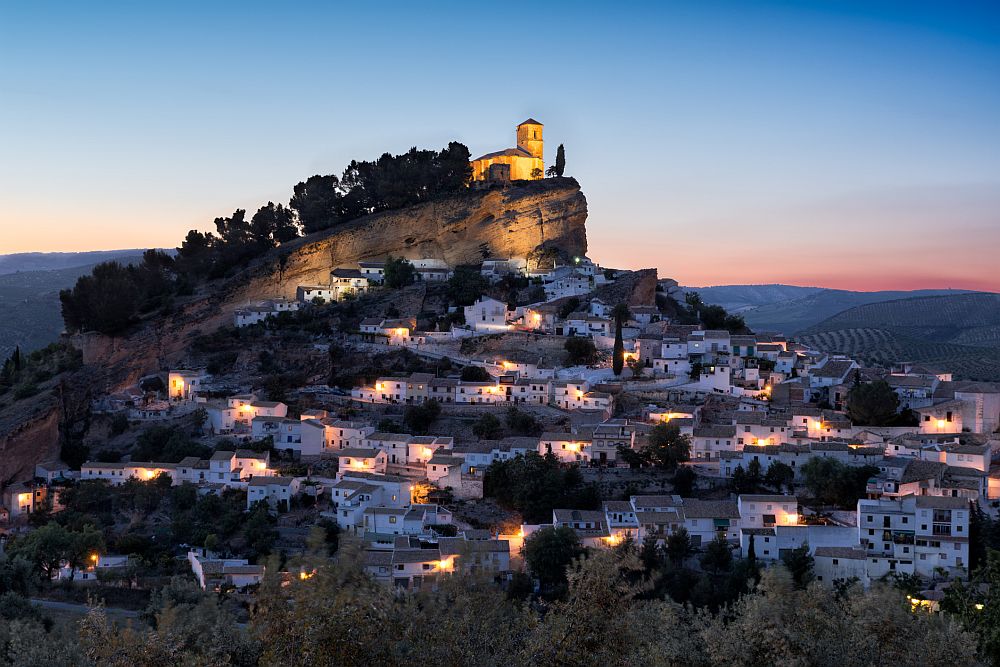
The “Route of the White Hill Towns” takes you through a chain of white villages sprawled over the rugged topography of Andalucia. Pueblos Blancos used to be home to a vigorous farming culture but the migration to cities for employment opportunities left the houses uninhabited. As a result, they fell into a state of near-disrepair.
Over time, though, tourists’ interest in these traditional Spanish villages led to their renovation. Now they sit atop the towering hills, picturesque whitewashed houses served with constricted pathways, and some really old churches.
Make sure to visit such wonderful villages like Grazalema that have a fine Moorish twist. Visit Arcos de la Frontera, Alcala del Valle, and more to experience authentic Spanish culture served raw. The panoramic views from these hilltop villages are stunning.
To wrap up your visit to the white-washed villages, pay a visit to the gothic church, la Santa Maria de la Coronado, and the historical Medina Sidonia. You will treasure these hidden historical jewels.
5. Madrid: The Fun-filled Capital City
View in gallery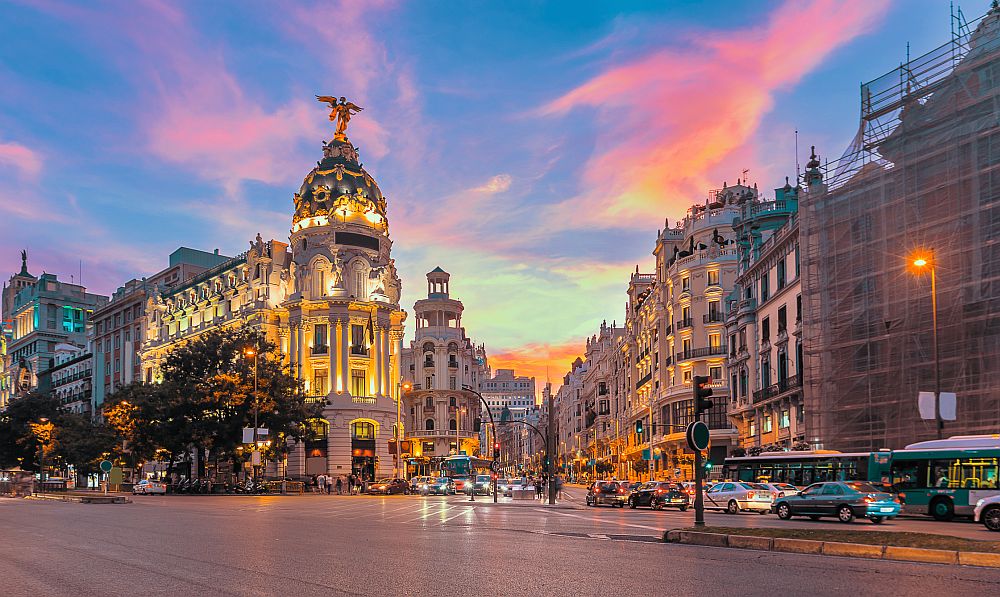
Spain’s capital Madrid is alive with street celebrations and music, boozing, art galleries, and food that will refresh your palate.
Madrid’s golden triangle of arts on the Paseo del Prado in the heart of Madrid is a dream come true for every art lover. Three top-notch national museums in close proximity may be more than what you bargained for. These include the Prado Museum (Museo del Prado), which contains art from before the 20th-century. The Reina Sofia (Museo Nacional Centro de Arte Reina Sofia) and Thyssen-Bornemisza Museum, on the other hand, focus on contemporary art.
Beyond museums, Madrid is an excellent place to shop, wine, and dine. You can sample local and international cuisines to suit your taste til the wee hours of the night. And the spectacular Royal Palace is truly a sight to behold.
The Plaza Mayor is a must-visit while in Madrid. It’s a 17th-century magnum opus with 237 balconies overlooking the square center. Sip your cold drink on the terraces as you behold an intricately-sculpted replica of King Felipe III upon a horse. The Plaza Mayor once hosted royal ceremonies, bullfights, judicial proceedings, and public executions. But these days it is more a gathering square for festivities like the traditional Christmas fair and market.
6. Ronda: The Iconic Bridge
View in gallery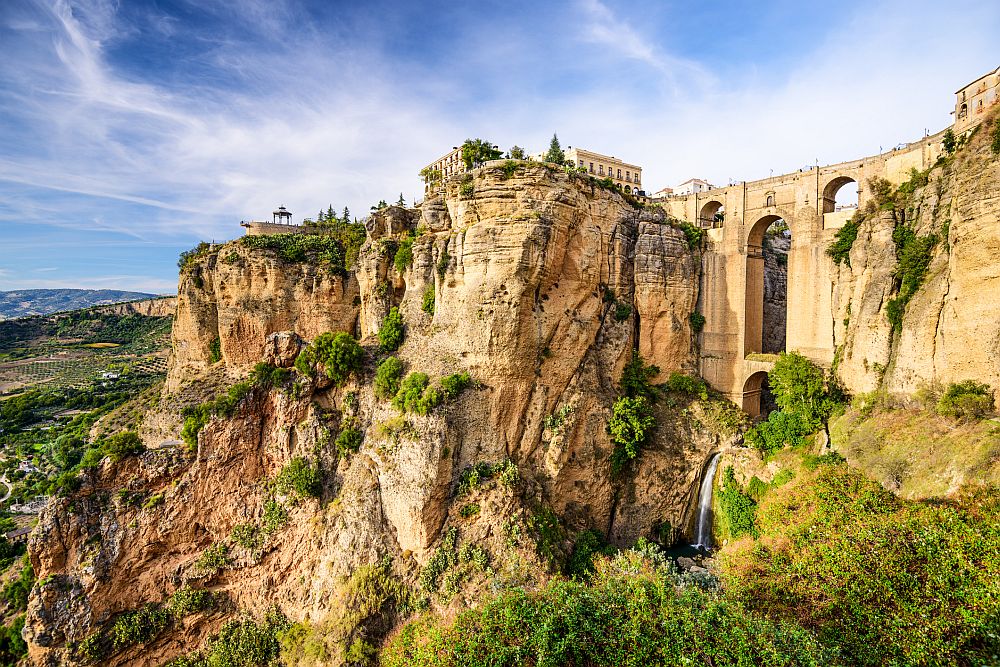
Ronda absolutely deserves a slot on your bucket list. This is an ancient town with a history dating back to over 2,000 years ago. Atop a hillside with steep cliffs running 300ft down a river gorge, Ronda is a lively city with a population of around 35,000. The city’s proximity to Malaga makes it a favorite Spanish tourist destination in the Andalucia region.
Prepare to take that perfect shot of the deep El Tajo Gorge from the New Bridge (The Puente Nuevo Bridge). Instagram aficionados will love to capture enviable shots of the gorge from different angles atop the bridge. After all, Puente Nuevo bridge is undoubtedly the signature landmark of Ronda. It connects the old town with the contemporary El Mercadillo sections of town and was built over a period of 42 years.
There’s much more to explore in Ronda. There is the Mondragon palace, complete with a museum and encapsulated in glorious gardens. Check out the Cuenca Gardens with its fantastic views of the city, or the picture-perfect Plaza Duquesa de Parcent. For Ronda’s historical past, visit the age-old Arabic walls that depict the city’s checkered past. And definitely check out the Plaza de Toros, the first bullfighting ring made entirely from stone in Spain.
7. Valencia: Dotted With Old & Modern Architecture
View in gallery
Valencia, like the rest of Spain, features historic architecture seen in medieval palaces, gothic cathedrals, and some pretty old buildings. However, its major attraction is the glamorous City of Arts and Sciences, a larger-than-life modern aquarium. Designed by the great Spanish architect Santiago Calatrava, this architectural complex is one of the most visited in Spain. And it’s not difficult to understand why.
The City of Arts & Science sits on a former river bed that was redirected after a disastrous flood that hit Valencia in the late 1950s. The River Turia was drained, creating the alley upon which this beauty lies. The project began in 1996 and was completed two years later, with more recent additions to the complex being opened in 2009. The megastructure features unusual shapes and curves that glow splendidly against the night floodlights.
Whereas the rest of the world view paella as Spain’s national food, the Spaniards trace its origin to Valencia. Enjoy a fresh-from-the-pan serving at the numerous seaside eateries, or at Valencia’s Central Market, spiced up with some modern culinary touches to excite your taste buds. You’ll want to return to Valencia with the whole family to sample its varied attractions.
8. Basque Country: Architectural Splendor
View in gallery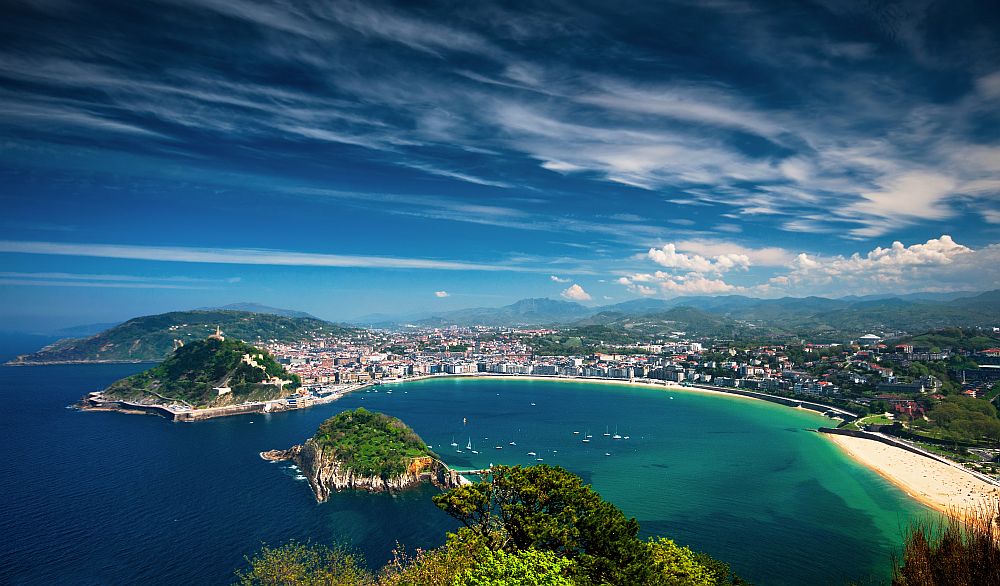
Basque Country plays host to a litany of attractions scattered throughout the region. San Sebastian, the city with picturesque beaches, and the iconic Guggenheim Museum are among its finest attractions.
San Sebastian’s culinary is heavenly, a retreat for the palate. The golden sands of La Concha Beach, replete with its turquoise blue waters and stunning architecture make for the perfect retreat spot. And try out the pintxos, an interesting snack popular in the Basque area–you’ll thank us later.
Explore the narrow streets of the Old Town as you dine in its numerous bars and restaurants. If you prefer some isolated coastline beach space, then try the more intimate Zurriola Beach.
To say that the Guggenheim Museum in Bilbao is a unique structure is an understatement. Designed by an American architect Frank Gehry, the museum at the banks of the Nervion River turned out to be such an iconic figure that photos can’t do it justice.
Completed in 1997, with an exterior made of huge glass sheets and titanium and limestone, this hyper-modern building appears ready for take-off. The phrases “The Bilbao Effect” and “architourism” were born from this museum depicting how this architectural masterpiece played a pivotal role in reviving the fortunes of Bilbao city.
You’ll be spoilt for choice, whether to admire the magnificence of the museum’s exterior, or the vast collection of treasured art pieces of this modern art museum.
9. Toledo: The Historic “Imperial City”
View in gallery
The entire city of Toledo is a national monument, and was declared a World Heritage Site in 1986. For context, Toledo served as the main seat of the Holy Roman Empire when King Charles V reigned. There is a wealth of history on display, well-preserved in the city’s ancient castles such as the Castillo de San Servando. It’s a cultural and architectural marvel, and a reminder of Spain’s glorious past as the seat of power of the Holy Roman Empire. It’s no wonder it’s referred to as the “Imperial City”.
But Toledo bears a heritage even older than that. Tracing back to Iberian blacksmiths from the 5th century BCE, you’ll find a dazzling array of works straight off the anvils of Spain’s finest silver and iron smiths. You can even pick up a traditional Spanish saber to call your very own.
Conclusion
There really are just too many beautiful places to visit in Spain. For example, we could have gone to The Balearic Islands, Tarragona, Picos de Europa, Costa Brava, Mount Teide, Cies Islands, and many more. But, we set out to narrow it down to a manageable list, and thus you have our top nine recommended Spanish destinations.
Spain is a land of beautiful beaches, medieval architecture, Moorish palaces, glamorous gardens, contemporary architectural marvels, breathtaking mountain ranges, a rich culture, a welcoming populace, and delicious cuisines. Visit and experience these attractions for yourself.




